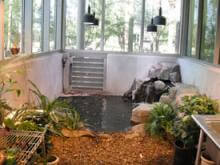Biology Greenhouse

The greenhouse, located at the northwest corner of the Life Science building (LS), is a multi-use, multipurpose facility for students and faculty of the biology department. We cultivate a variety of plant species that demonstrate diverse plant adaptations. The controlled environment of the greenhouse is ideal for maintaining plants like delicate, water-loving mosses and ferns. In addition, we are cultivating rare and unusual native plants that could be planted in the landscaping around the Life Sciences building.
In addition, the greenhouse is home to a freshwater pond that is part of a riparian habitat for native fish and frogs. This pond is currently providing refuge for a displaced population of leopard frogs as well as Longfin Dace (as seen in photo).
The pond is also used to grow aquatic and semi-aquatic plant specimens as well as a natural populations of various protozoans and algae. Biology students practice their microscope skills searching for these tiny inhabitants of the GCC pond.
Biology Projects
Riparian Habitat
Over 100 frogs and tadpoles, whose habitat was threatened by the Monument Fire that scorched large swaths of southeastern Arizona in June, 2011, were transplanted from a pond in Hereford to a temporary home in GCC's riparian habitat. While GCC had designed the habitat for just such a colony of Chiricahua Leopard Frogs, the biology department had not yet introduced any frogs. Thus GCC's pond was available as a temporary refuge for these displaced animals.
The frogs were taken from their natural habitat just before the summer rains filled their pond with soil. A lack of vegetation in the surrounding fire damaged areas made the ground unstable and easily washed away by the flood waters.
The frogs stayed at GCC through the summer and received publicity from azcentral.com, Cronkite News Service and Cronkite News.
Biology faculty worked with biologists from the Arizona Game & Fish Department and the U.S. Fish and Wildlife Service to establish breeding populations of Longfin Dace (Agosia chrysogaster) and Chiricahua Leopard Frogs (Rana chiricahuensis) in the greenhouse pond.
Longfin dace live in desert streams throughout Arizona. In our pond, they effectively keep the mosquito larvae population under control.
Leopard frogs are disappearing across the US and especially in Arizona. While the reasons for their demise are still being studied, biologists have identified introduced predators, disease, drought and loss of habitat as major causes.
Watch the video above about how the frogs came to their new home, designed and built by Arizona Alternative Building Systems LLC.